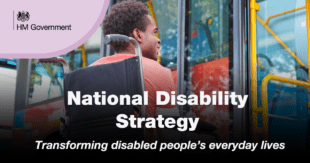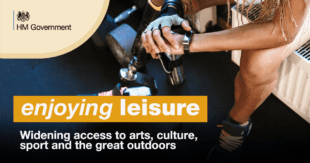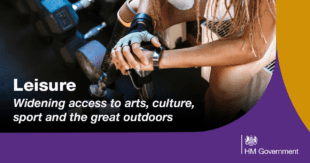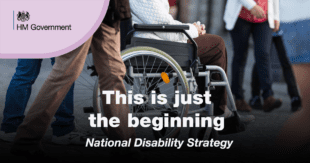We have published the Government’s National Disability Strategy.
Over one in five people in the UK are disabled.
'What does disability mean to me? The usual connotations - I find it harder to do certain things than others would. I see things differently. I don’t struggle. I have just spent my life finding efficient ways of getting round the challenges I’ve had.'
-Beth
Our vision is to transform the everyday lives of disabled people by tackling the barriers people face. So we can build back better towards a society that works for everyone. The strategy sets out immediate actions we will take on our path towards a longer-term goal, rooting the strategy in the everyday experience of disabled people.

This series explains the strategy’s eight key themes, and how we are making improvements to every part of a disabled person’s day. From the moment someone gets up to the moment they end their day.
Leisure: Widening access to arts, culture, sport and the great outdoors

Spending time with family and friends and doing the things we enjoy is a vital part of everyday life. But too many disabled people are missing out.
Practical accessibility issues, stigma, and the need to carefully manage energy levels and pain, are all barriers to socialising and participation. 90% of disabled people who had accessed culture, sport and leisure services had experienced at least some difficulties.
Each person has the right to enjoy their lives, we want everyone to have access to arts, culture, sport and the great outdoors.
Widening participation in art, culture and sport
We will widen participation in arts, culture and sport. Disability is one of the main barriers people give for not attending art and cultural events, and disabled people are nearly twice as likely to be physically inactive.
There is wide support amongst disabled people for a national arts access scheme.
'I have disabilities as a result of Meningitis. Whilst a student at The Orpheus Centre in Godstone I developed a passion for song-writing and performance. Working with places like Orpheus, and later Freewheelers and Extant, make me realise how important the performing arts are in helping disabled people develop confidence.'
-Luke
Tourism
We are committed to making the UK the most accessible tourism destination in Europe by 2025, as set out in the Tourism Recovery Plan.
The ultimate ambition is for the UK to have the most accessible tourism offer in the world.
DCMS will:
- work with VisitBritain and VisitEngland and other stakeholders in the tourism sector to promote the importance of accessible tourism in the media and to businesses
- partner with the Inclusive Tourism Action Group and promote the National Accessible Scheme which rates tourist accommodation based on its suitability for guests with accessibility requirements
- hold a series of roundtables, hosted by the Minister for Sport and Tourism, with stakeholders across the tourism industry to better understand the barriers disabled people face as tourists.
Improving access to nature
People with a long-term illness or health conditions are around 25% less likely to have enjoyed nature in the past 14 days than others.
In our 25 year Environment Plan, we committed to making sure that there are accessible natural spaces close to where people live and work, and to encourage more people to spend time in them to benefit their health and wellbeing.
The Department for Environment, Food and Rural Affairs (DEFRA) leads a £5.7 million investment in green social prescribing - supporting people to engage in nature based interventions to prevent mental ill health and reduce health inequalities. Many disabled people will benefit.
More inclusive playgrounds
Play is an important part of growing up. It offers not only enjoyment but supports children’s social, emotional, intellectual and physical development.
Yet for disabled children, the opportunities to join in play are far fewer. As a result, the opportunities to develop are also reduced. Playgrounds and other play settings can fall short in providing inclusive facilities.
'My youngest son, who has cerebral palsy and epilepsy and is registered blind, loves to play and be swung around as much as any child. But as he’s grown older and bigger we’ve found it hard to find playgrounds that are accessible. This has left our whole family excluded. All children deserve and have a right to access play parks.'
- Becky
We are determined to increase opportunities for disabled children and their families, tackle barriers and enable the simple enjoyment of play for every child, wherever they live.

What are our next steps?
- Arts Councils across the UK are working together and with the British Film Institute to launch a free, UK-wide arts access card by March 2022.
- DEFRA will make the England Coast Path as easy to use as possible for disabled people. With all stretches of the England Coast Path open or with establishment works underway by the end of 2021 (unless there are ongoing planning or legal issues.)
- Accessible playgrounds – the Ministry of Housing, Communities and Local Government (MHCLG) will publish a new National Model Design Code in the summer, setting out design considerations for local planning authorities to stress the importance of providing accessible and inclusive play spaces and equipment for all.

This is only the beginning.
We see the National Disability Strategy as a dynamic plan that we will refresh regularly in response to disabled people’s priorities.
Join the conversation
- Sign up to our newsletter to hear what we’re doing.
- Follow us on Twitter to stay up-to-date with our plans.
Want to know more about the National Disability Strategy?
Read about the other seven Strategy themes:
- Rights and perceptions: Removing barriers to participating fully in public and civic life and wider society
- Home: Creating more accessible, adapted and safer homes
- Transport: Improving the accessibility and experience of everyday journeys
- Jobs: Making the world of work more inclusive and accessible
- Education: Ensuring children and young people fulfil their potential
- Shopping: Creating more consumer choice and convenience
- Public services: Making access as smooth and easy as possible
Leave a comment